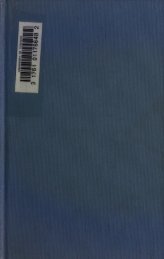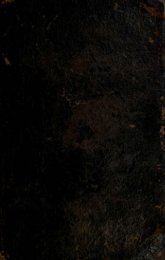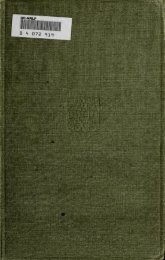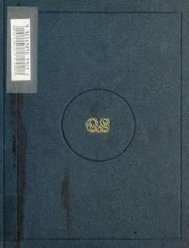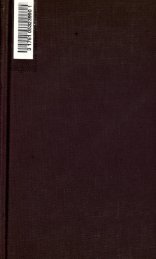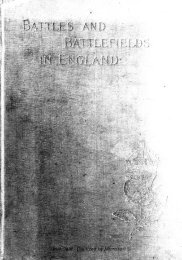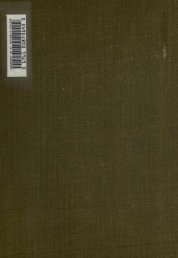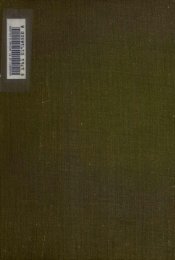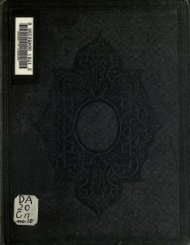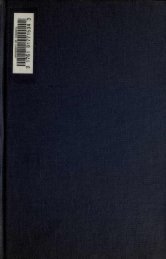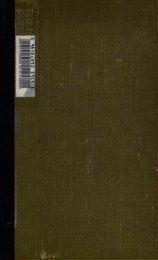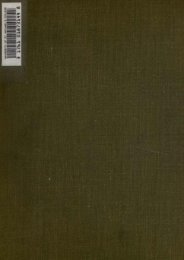Perkin Warbeck (NZ version) - Richard III Society - New Zealand ...
Perkin Warbeck (NZ version) - Richard III Society - New Zealand ...
Perkin Warbeck (NZ version) - Richard III Society - New Zealand ...
Create successful ePaper yourself
Turn your PDF publications into a flip-book with our unique Google optimized e-Paper software.
Whether my hero was or was not an impostor, he was<br />
believed to be the true man by his contemporaries 1 .<br />
<strong>Perkin</strong> <strong>Warbeck</strong><br />
Talk to the Australasian Convention of the <strong>Richard</strong> <strong>III</strong> <strong>Society</strong>,<br />
Upper Hutt, <strong>New</strong> <strong>Zealand</strong>, 13 - 15 April 2007<br />
Dorothea Preis<br />
The young man, called by Henry VII's spin doctors, "<strong>Perkin</strong> <strong>Warbeck</strong>", has been<br />
surrounded by controversy ever since he first appeared on the world stage. He<br />
claimed to be <strong>Richard</strong>, Duke of York, the younger son of Edward IV, and thus<br />
would have been the brother of Henry's Queen Elizabeth. As <strong>Perkin</strong> <strong>Warbeck</strong> he<br />
is often regarded by historians as a footnote of little consequence to the glorious<br />
Tudor reign, and this is certainly the image that the Tudors liked to create. As we<br />
shall see, whatever Henry’s efforts at portraying the affair, this young man had<br />
him seriously worried and was widely accepted as <strong>Richard</strong> of York.<br />
As we know according to Tudor history <strong>Richard</strong> <strong>III</strong> was that evil monster who<br />
killed his poor innocent nephews. Therefore anyone claiming to be one of these<br />
nephews had to be an impostor, and a rather stupid one at that. However, there<br />
is no proof that they were indeed murdered by their uncle, or anyone else for that<br />
matter, and once we acknowledge this, we can have a more unbiased look at this<br />
young man’s identity.<br />
When Henry came to the throne he had the Titulus Regius, stating that Edward<br />
IV's children were illegitimate, revoked, in order to have an added claim to the<br />
throne through his wife. This would have left her two brothers, if they were alive,<br />
with a better claim than Henry 2 . So when first a young man appeared saying he<br />
was Edward IV's elder son Edward and later another young man claimed to be<br />
<strong>Richard</strong>, they were seen as the great hope of the Yorkist cause.<br />
I think that there is a very good chance that this young man was indeed who he<br />
claimed to be: <strong>Richard</strong> of York.<br />
We can only speculate on what happened to the boys, when they were no longer<br />
1<br />
Mary Shelley, The Fortunes of <strong>Perkin</strong> <strong>Warbeck</strong>, quoted in Garbin, Lidia, “The Fortunes of <strong>Perkin</strong><br />
<strong>Warbeck</strong>: Walter Scott in the Writings of Mary Shelley”.<br />
http://www.erudir.org/revue/ron/1997/v/n6/005752ar.html<br />
2<br />
Arthurson, Ian, The <strong>Perkin</strong> <strong>Warbeck</strong> Conspiracy 1491-1499. Alan Sutton Publishing, Stroud, 1994,<br />
p.190
seen at the Tower. There is the possibility that they were smuggled to their aunt<br />
Margaret of Burgundy (Edward IV and <strong>Richard</strong> <strong>III</strong>'s sister), possibly with the help<br />
of Sir James Tyrell and/or Sir Edward Brampton 3 .<br />
1. Short Summary of <strong>Perkin</strong>/<strong>Richard</strong>'s life<br />
Following is a short summary of the life of the young man that came to be known<br />
as <strong>Perkin</strong> <strong>Warbeck</strong>.<br />
1.1 Some time after Easter 1487 (i.e. before the Battle of Stoke on 16 June<br />
1487, where an earlier pretender, who by the Tudors would be referred to as<br />
Lambert Simnel, was defeated 4 ) a young man arrived in Portugal in the company<br />
of Sir Edward Brampton and his wife on a ship sent by the Portuguese King. He<br />
stayed until 1491. Even during this time there were said to be many who<br />
regarded him as <strong>Richard</strong> of York 5 .<br />
1.2 In the autumn of 1491 this young man appeared in Cork in Ireland<br />
claiming to be <strong>Richard</strong>, Duke of York. He arrived on a ship owned by Pregent<br />
Meno and was wearing fine silk clothes 6 . He found some support in Ireland, but<br />
not enough 7 .<br />
1.3 In June 1492 the French King, Charles V<strong>III</strong>, invited him to France, and he<br />
went there. His presence helped Charles to get Henry to the negotiating table.<br />
So when the treaty was signed in December 1492, he had no more use for him 8 ,<br />
and the young man had to look for new backers.<br />
1.4 From France he went to Margaret in Burgundy, <strong>Richard</strong>’s aunt. Through<br />
Margaret he got into contact with Maximilian I, Emperor of the Holy Roman<br />
Empire of the German Nation 9 . Maximilian proved to be one of his most<br />
steadfast supporters. His big problem was that he was always strapped for cash,<br />
due to the reluctance of his subjects to allow him funds 10 . He did finance an<br />
invasion force for the pretender.<br />
1.5 Unfortunately Henry had found out about the plans and had got rid of<br />
3<br />
Williamson, Audrey, The Mystery of the Princes. Alan Sutton, 1981 pp.114-130<br />
4<br />
Smith, Gordon,“Lambert Simnel and the King from Dublin”, The Ricardian, Vol.10, No. 135, December<br />
1996 (also published on web page of The <strong>Richard</strong> <strong>III</strong> <strong>Society</strong>)<br />
5<br />
Wroe, Ann, The Perfect Prince. Random House, <strong>New</strong> York, 2003, p. 19 & p. 41<br />
6<br />
Wroe, Perfect Prince, pp. 48 - 49<br />
7<br />
Kleyn, Diana, <strong>Richard</strong> of England. Jacobyte Books, Australia, 2001, pp. 87 - 89<br />
8<br />
Wroe, Perfect Prince, pp. 114 - 120, Kleyn, p. 91<br />
9<br />
Wroe, Perfecty Prince, pp. 148 ff<br />
10<br />
Kleyn, p. 111 Later on in his reign he actually mortgaged the mines in Tyrol in order to borrow money<br />
of the Fugger banking family. (Gisela Sachse’ “Kaiser Maximilian I - Bewahrer und Reformer.<br />
http://www.aski.ork/kb_202/kb202maximilian.htm)
<strong>Richard</strong>'s support base in England before his arrival 11 . On 3 July 1495, <strong>Richard</strong><br />
arrived off Deal in Kent. Some of his men went on land, where they were<br />
greeted by the men of Kent, who invited the Pretender ashore. He seems to<br />
have suspected a trap, which indeed it was, and stayed on board, as Henry had<br />
done in a similar situation. Most of those, who had landed, were executed, a few<br />
made it back to the ships 12 .<br />
1.6 <strong>Richard</strong> then went back to Ireland, but here Henry had got rid of <strong>Richard</strong>'s<br />
support base as well 13 .<br />
1.7 So <strong>Richard</strong> accepted an invitation from James IV of Scotland, where he<br />
arrived on 20 November 1495. James proved to be his other faithful supporter.<br />
He financed him and his court during his stay in Scotland. <strong>Richard</strong> married<br />
James's relative Catherine Gordon in January 1496 14 , and it seems likely that<br />
they had a son in September (though the sources differ about this) 15 .<br />
1.8 In September James organized an invasion of England on his behalf. On<br />
the eve of the invasion <strong>Richard</strong> issued a proclamation. However, the expected<br />
support for <strong>Richard</strong> did not materialize and the whole exercise ended in being<br />
just another border raid. <strong>Richard</strong> was so disgusted by the mayhem that he<br />
returned to Scotland, which left James with no option but to follow 16 .<br />
1.9 In June 1497 there was a revolt by Cornishman and others against<br />
Henry's taxation. They marched to London, but were defeated and punished 17 .<br />
1.10 Henry began peace negotiations with James, which made it impossible for<br />
<strong>Richard</strong> to stay. He, his family and followers left in July 1497 on a merchant ship<br />
with no weapons or soldiers 18 , leaving behind a fair amount of debt. After being<br />
chased from Ireland they landed on 7 September 1497 in Cornwall, too late for<br />
the above-mentioned uprising 19 . He found a fair amount of support among the<br />
common people, while the nobiliy adopted a wait-and-see attitude.<br />
1.11 <strong>Richard</strong> first tried his luck in Exeter. However, the citizens closed their<br />
gates to him. As he had neither military expertise nor equipment, they were<br />
forced to withdraw.<br />
11 Kleyn, pp.114 - 118<br />
12 Kleyn, pp. 126-127<br />
13 Kleyn, pp. 128-129<br />
14 Kleyn, pp 137-141<br />
15 Wroe, Perfect Prince, p. 269 and pp. 298-299. However, Kleyn states that they did not have any<br />
children, or if they had, it must have died during the journey (Kleyn, p. 172).<br />
16 Kleyn, pp. 151-156. Full Text of the proclamation is included as Appendix V, pp. 258-262<br />
17 Kleyn, pp. 167-170<br />
18 Wroe, Perfect Prince, p. 314<br />
19 Kleyn, pp. 170-175
1.12 He then moved to Taunton. He and his close supporters vanished during<br />
the night before the battle, leaving his host without leaders. He tried to get to<br />
Southampton, but did not find any ships there and then asked at Beaulieu Abbey<br />
for sanctuary. The abbot apparently tipped Henry off and <strong>Richard</strong> was arrested.<br />
He was said to have made a full confession 20 . On his arrest <strong>Richard</strong> was made<br />
to believe that Henry would pardon him, however, such a pardon was never<br />
given 21 .<br />
1.13 At first <strong>Richard</strong> lived in Henry's retinue at court under light house arrest.<br />
He was given servants , a horse and a tailor 22 . He was allowed to see his wife,<br />
though not sleep with her 23 . His wife had been sent to Queen Elizabeth 24 . We<br />
do not know what happened to their child, if indeed there was one, after<br />
Catherine's arrival in London. There are clues that it was sent to Wales 25 .<br />
1.14 In June 1498 <strong>Richard</strong> tried to escape. It seems likely that Henry arranged<br />
for his guards to turn a blind eye. <strong>Richard</strong> asked for sanctuary at Shene Abbey,<br />
but the prior informed Henry. <strong>Richard</strong> was arrested and brought to the Tower,<br />
where Edward of Clarence had been imprisoned since 1485 26 .<br />
1.15 Probably again with Henry connivance, <strong>Richard</strong> and Edward tried to<br />
escape in 1499, but were quickly caught. This gave Henry the argument to have<br />
them tried for high treason and in November 1499 executed 27 .<br />
2. Confession and Letter to Mother<br />
So what about the famous confession? By historians in the Tudor tradition this is<br />
usually seen as absolute proof that he was an impostor, arguing that "there is<br />
nothing in [his] confession which should make us doubt his truthfulness" 28 .<br />
Somehow they cannot have looked at it too closely.<br />
2.1 Officially the confession was made in October 1497 after <strong>Richard</strong>'s<br />
capture. However, large parts of it had been published by Henry as early as<br />
20 Kleyn, pp. 179-185<br />
21 Wroe, Perfect Prince, p. 372<br />
22 Wroe, Ann, “The Debate: Who Was <strong>Perkin</strong> <strong>Warbeck</strong>?” Ricardian Bulletin, Summer 2005 (pp. 24-27),<br />
p. 26<br />
23 Wroe, Perfect Prince, pp. 433-434<br />
24 Wroe, Perfect Prince., p.186<br />
25 Wroe cites two families in Wales, who trace their origin to a <strong>Richard</strong> <strong>Perkin</strong>s, the son of “Peter Osbeck<br />
of Tournai“. It has to be remembered that <strong>Richard</strong> of York had never been to Wales, so it would make a<br />
good hiding place for his son. Catherine also lived later on for a while near one of the families (Perfect<br />
Prince, p. 506) .<br />
26 Kleyn, pp. 203-205<br />
27 Kleyn, pp. 216-223<br />
28 Arthurson, p. 2
1493 29 . It seems more likely that <strong>Richard</strong> was just asked to sign on the dotted<br />
line and repeat what he was told. As Henry was holding on to his wife and<br />
possible child, this would have been quite a strong inducement to go along with<br />
it 30 . We only have copies of the confession, no original 31 - rather negligent of<br />
Henry and his administration! Nor has Polydore Vergil, Henry’s official historian,<br />
heard of it 32 . In addition there are marked differences in the contents of copies in<br />
French and copies in English 33 .<br />
2.2 Earlier Henry had always claimed that this was <strong>Perkin</strong> <strong>Warbeck</strong>, the son of<br />
Jehan Werbecque from Tournai. However, in the confession the father is<br />
suddenly John Osbeck. It has been said that the secretary who wrote down the<br />
confession misheard or mis-spelt the surname, but Osbeck is quite different from<br />
<strong>Warbeck</strong> or the French Werbecque 34 . And would they not have made sure to get<br />
the names right in an important document like this?<br />
2.3 At about the same time <strong>Perkin</strong> was supposed to have written a letter to his<br />
mother, again we only have copies. Here we have the same confusion with<br />
names. The surname now is Warbecque, but he refers to his supposed mother<br />
as Kateryn or Catherine, while according to the Tournai archives she was Nicaise<br />
or Caisine, which does not seem to be the same 35 .<br />
2.4 According to the confession the father was a boatsman and customs<br />
collector in Tournai. This means that the family would have been part of a class<br />
which was "well-educated, highly mobile [and] associating with the princely<br />
court" 36 . Would such a family not have been the perfect hiding place for a little<br />
prince? Their comparative obscurity would have provided a certain safety 37 .<br />
And after all the young <strong>Richard</strong> <strong>III</strong> also spent time with the Paston family 38 .<br />
2.5 The English <strong>version</strong> then continues to tell us about some moving around<br />
in Burgundy in order to learn Flemish. We know that the family actually was of<br />
Flemish origin, as also their surname suggests, so the boy could have learnt the<br />
language at home 39 . Later on it was found that he spoke much better English<br />
than either French, as spoken in Tournai, or Flemish. If these travels ever took<br />
29<br />
Wroe, “The Debate”, p. 25<br />
30<br />
Wroe, “The Debate”, p. 25.<br />
31<br />
Kleyn, p. 190 + p. 197<br />
32<br />
Fields, Bertram, Royal Blood. <strong>Richard</strong> <strong>III</strong> and the Mystery of the Princes. Regan Books, <strong>New</strong> York,<br />
1998, p. 234: see also Wroe, “The Debate”, p. 26<br />
33 Wroe, Perfect Prince, pp. 381-384<br />
34 Kleyn, pp. 190-193<br />
35 Kleyn, pp. 193-197, see also Fields, p. 216<br />
36 Arthurson, p. 28<br />
37 It is also worth noting that Tournai was a “free city that anyone could enter without safe-conducts”, cf.<br />
Kleyn, p. 4.<br />
38 Helen Castor, Blood & Roses, Faber and Faber Ltd, London, 2004, p. 138<br />
39 Wroe, Perfect Prince, p. 393
place, they might just have been to shake off Henry's spies.<br />
2.6 In the French <strong>version</strong> on the other hand the boy stays in Tournai, where<br />
"no expense was spared to educate him" and "tutors and guardians" were<br />
employed 40 . Surely Aunt Margaret would have seen to it that <strong>Richard</strong> received a<br />
proper education.<br />
2.7 According to the confession he arrived in Cork in the service of Pregent<br />
Meno, modelling silks for him in the town. Some Yorkists just happen to be<br />
around and immediately decide that he would make the perfect front man for<br />
their cause 41 . It just does not make sense that they would use someone, who<br />
does not even speak English, to play an English prince when plenty of legitimate<br />
claimants were around. 42<br />
In any case Meno was not a silk merchant either, but traded in raw wool. The<br />
French <strong>version</strong> also says that the silk clothes were <strong>Richard</strong>'s own 43 . And Henry<br />
stated in a letter that Meno was basically the ferryman who brought <strong>Richard</strong> to<br />
Ireland 44 . We know the meeting with the Yorkists was not just a coincidence, but<br />
had been carefully arranged. <strong>Richard</strong> had announced his impending arrival to<br />
the Earls of Desmond and Kildare by letter 45 .<br />
2.8 The confession says that he was forced against his will to play the prince.<br />
In order to play <strong>Richard</strong>, he had to learn English and courtly manners and details<br />
about Edward IV's court 46 . Anyone who ever learnt a foreign language knows<br />
that it is impossible to speak it fluently and without any accent within 5 months.<br />
And this was a student who did not even want to learn! Quite apart from the fact<br />
that none of his teachers was of a social standing to have spoken the court<br />
English. There are enough regional differences in the English of today, how<br />
much more would there have been in the 15th century! Nor would they have had<br />
the necessary knowledge in courtly manners or about goings on at Edward IV's<br />
court. To send him to France after only a short crash course in how to be a<br />
prince, would surely have been rather risky, as his lack of elegance and<br />
refinement would have been noticed easily, but this was not the case 47 .<br />
2.9 As already mentioned we have not only copies of his confession, but also<br />
the copy of a letter to his mother, in which he gets basically everything wrong,<br />
nor does it show any emotion of a son to his mother 48 . He mentions certain<br />
40 Wroe, Perfect Prince, p. 393; Kleyn , p. 79<br />
41<br />
Wroe, Perfect Prince, p. 94<br />
42<br />
Wroe, “The Debate”, p.25<br />
43<br />
Wroe, Perfect Prince, pp. 49-50<br />
44<br />
Wroe, Perfect Prince, p. 100<br />
45<br />
Wroe, Perfect Prince, P.49<br />
46<br />
Wroe, Perfect Prince, pp. 95-98<br />
47 Kleyn, p. 89<br />
48 Wroe, “The Debate”, p. 25
events in their lives allegedly to proof that he really is her son. However, all this<br />
shows is that he seems to know about them, as a foster child would as well. And<br />
the events do not add up either. He refers to the death of his sister Jehanne<br />
from the plague in 1487, while according to the archives she was still alive and<br />
married in 1517. Nor was there any plague in Tournai in 1487 or about that time.<br />
The letter also mentions the death of the father in 1497, when the archives<br />
indicate that he only died in 1498 49 .<br />
All this shows that some serious doubts regarding the truthfulness of the<br />
confession are justified.<br />
3. Behaviour of European Rulers<br />
Another reason for his being an impostor is often seen in the support he received<br />
from other European rulers. The theory goes that they needed someone for their<br />
own ends to play the prince and that they dropped him as soon as he had<br />
reached his use-by-date 50 . This logic seems somewhat flawed: a real prince<br />
would have served the same purpose as an impostor. Nor can it be maintained<br />
that they all got something out of it, nor did all drop him. Lets look at the actions<br />
of these rulers more closely:<br />
3.1 Charles V<strong>III</strong> of France: He certainly used him for his own ends. However,<br />
while <strong>Richard</strong> was at his court, Charles wrote to James IV of Scotland that this<br />
was indeed <strong>Richard</strong> of York. In the treaty Henry had demanded that he should<br />
hand <strong>Richard</strong> over to Henry, but Charles facilitated his escape instead 51 . Nothing<br />
there to show that he thought him an impostor!<br />
3.2 Margaret of Burgundy: If we accept that the two boys were smuggled out<br />
of England and she was responsible for hiding them, she would have known who<br />
this young man was. Since 1488 she was in regular contact with James IV of<br />
Scotland about her nephew. From 1490 onwards, when he was still in Portugal,<br />
she actively spread rumours that <strong>Richard</strong> was alive 52 . She tirelessly worked<br />
towards the restoration of the House of York, which brought her a bad press from<br />
Tudor historians. They say that she taught the young man all the details he knew<br />
about the court of Edward IV. However, she had left England before <strong>Richard</strong><br />
was born and only returned for a short visit in 1480 and would not have known<br />
much herself 53 .<br />
I doubt, whether someone with such a strong sense of family, as she by all<br />
49 Kleyn, pp. 197-198<br />
50 An example is Macdougall, p. 23. Macdougall, Norman, “The Debate: Who was <strong>Perkin</strong> <strong>Warbeck</strong>?”<br />
Ricardian Bulletin, Summer 2005, pp. 22 - 24<br />
51 Wroe, Perfect Prince, pp. 115-120<br />
52 Wroe, Perfect Prince, p. 91<br />
53 Kleyn, pp. 96-97
accounts had, would have supported an impostor, while plenty of real Yorkists<br />
with a possible claim where still around. When she died in 1503, while not<br />
mentioning her nephews directly, her will included money for Masses for "those<br />
souls to whom we feel bound" 54 .<br />
3.3 Maximilian I of the Holy Roman Empire of the German Nation: Maximilian<br />
was a highly intelligent man and was known to be a very good judge of<br />
character 55 . He had a natural sympathy for Yorkist causes, stemming from<br />
affection for Margaret and his gratitude for friendship shown to him by both<br />
Edward IV and <strong>Richard</strong> <strong>III</strong> 56 . He had been married to Marie, Margaret’s stepdaughter,<br />
and this seems to have been true love match 57 . Yet this cannot<br />
explain his continuing support for the young man, he always referred to as<br />
<strong>Richard</strong>, Edward IV's son or the Duke of York.<br />
His main drawback was that he was always short of money and had great<br />
problems to get his subjects to allow him funds for any enterprise 58 . He is often<br />
referred to as “The Last Knight” and is famous for saying that “other countries<br />
may go to war, but you, happy Austria, marry” 59 . This does not sound like a man<br />
who chooses to go to war just for the fun of it, but needs a very good reason to<br />
do so.<br />
It is questionable whether he had enough to gain from a change on the English<br />
throne to fund an impostor. True, the young man signed something likea Will, in<br />
which he makes over to Maximilian and his son Philip his rights to the English<br />
throne should he die without male issue 60 , but as <strong>Richard</strong> was only 21 at the<br />
time this seems to be a far shot. Maximilian continued to do what he could for<br />
<strong>Richard</strong>, even after his capture and the publication of the confession. When he<br />
was negotiating a treaty with Ferdinand and Isabella of Spain in the late 1490s,<br />
after <strong>Richard</strong>’s capture, by which both parties agreed not to give any support to<br />
Henry's enemies, he tried to have <strong>Richard</strong> specifically excluded 61 .<br />
3.4 James IV of Scotland: James paid for all of <strong>Richard</strong>'s and his entourage's<br />
expenses during his stay in Scotland. He also paid for his wedding, his wife's<br />
expenses and paid him a pension. He then funded the attempted invasion from<br />
the North. Somehow <strong>Richard</strong> seems to be a very expensive reason for a border<br />
raid - a pastime that the Scottish and English had been engaged in for centuries.<br />
54<br />
Wroe, Perfect Prince, p. 521<br />
55<br />
Kleyn, p. 111<br />
56<br />
Wroe, Perfect Prince, p. 206<br />
57<br />
Kleyn, p. 111<br />
58<br />
Kleyn., p. 111 Later on in his reign he actually mortgaged the mines in Tyrol in order to borrow money<br />
of the Fugger banking family. (Gisela Sachse’ “Kaiser Maximilian I - Bewahrer und Reformer.<br />
http://www.aski.ork/kb_202/kb202maximilian.htm)<br />
59<br />
http://www.goethe.de/Maximilian_1_(HRR).html<br />
60 Wroe, Perfect Prince, pp. 122-123<br />
61 Wroe, Perfect Prince, p. 245
I also doubt he would have supported the marriage of his relative to a poor<br />
adventurer. And when during the peace talks with Henry, it was demanded to<br />
hand over <strong>Perkin</strong> <strong>Warbeck</strong>, he rather sent him on his way with full honours. He<br />
managed to get later a clause inserted into the treaty, which would have allowed<br />
<strong>Richard</strong> to seek sanctuary in Scotland, had he been able to get there 62 . He<br />
married Henry and Elizabeth's daughter Margaret in 1503, but always continued<br />
to refer to <strong>Richard</strong> as the Duke of York. Legend has it that he had <strong>Richard</strong>’s<br />
body brought to Scotland and buried in the vault he had prepared for himself,<br />
next to his parents 63 .<br />
3.5. Ferdinand and Isabella of Spain 64 : As they were at the time negotiating<br />
the marriage of their daughter Catherine to Henry's son Arthur they were<br />
definitely not interested in destabilizing Henry's position. They insisted that at the<br />
time of the wedding no other claimant to the English throne should be around 65 ,<br />
which to a certain extent sealed the fate of <strong>Richard</strong> as well as Edward of<br />
Clarence. While publicly always proclaiming that he was an impostor, privately<br />
they actually acknowledged him. There exists the codebook for a list of ciphers,<br />
which they used for important persons in secret correspondence with their<br />
ambassadors. Here in the chapter on royal persons we find <strong>Richard</strong>, the Duke of<br />
York 66 . After <strong>Richard</strong>'s capture and his confession their ambassador to London<br />
still urged his sovereigns to liberate "The Duke of York ... and the Duke of<br />
Clarence who were prisoners" 67 .<br />
3.6 Margaret of Burgundy was instrumental in bringing him to the notice of all<br />
the princes of Europe, who accepted him as the rightful King of England with the<br />
possible exception of the Kings of Spain and later the King of France 68<br />
So we see whatever they might have said publicly in general European rulers<br />
accepted him as <strong>Richard</strong>.<br />
62 Kleyn, pp. 178-179<br />
63 Wroe, Perfect Prince, pp. 510-511<br />
64 Isabella, as well as the King of Portugal, actually had a better claim to the English throne than Henry, as<br />
both were descended from legitimate daughters of John of Gaunt (Fields, p.153)<br />
65 Kleyn, p. 212 + p. 257<br />
66 Kleyn, p. 210-212<br />
67 Kleyn, p. 189<br />
68 Kleyn, p. 108
4. Behaviour of Other Persons<br />
So what about all the other people who came across him or might have had an<br />
interest in him.<br />
4.1 Sir Robert Clifford: He had known both Edward VI and <strong>Richard</strong> <strong>III</strong> well.<br />
When he went to join the Pretender in Flanders, he wrote home that he was<br />
convinced that this really was <strong>Richard</strong> 69 . He was then offered money and a<br />
pardon by Henry's spies and returned to England, where he gave the whole plot<br />
away. It is possible that he was a double agent all along 70 . However, why would<br />
he claim to his family to have recognized <strong>Richard</strong>?<br />
4.2 Sir William Stanley: Rather infamous from Bosworth. He was Henry's<br />
step-uncle and Lord Chamberlain. According to Clifford, Stanley had stated that,<br />
if he knew for certain that the young man was the son of King Edward, he would<br />
never wear arms against him. Stanley was also charged with offering <strong>Richard</strong><br />
financial support and promising to rise for him 71 . Several of those arrested on the<br />
basis of Clifford's allegations had close links to him as well as to the queen, the<br />
court and other children of Edward IV 72 . They were executed for their support for<br />
<strong>Richard</strong> without recanting their belief that he was the real pretender 73 .<br />
4.3 Catherine Gordon: <strong>Richard</strong>'s wife never said anything against her first<br />
husband. After his capture and confession she seems to have insisted on<br />
remaining married to him 74 . Had he married her under an assumed name,<br />
however, this would have immediately dissolved the marriage under canon law 75 .<br />
After his death she waited 11 years before remarrying. She had altogether three<br />
more husbands, and possibly had a daughter, who became the ancestor of the<br />
Earls of Pembroke 76 . She wore black until her death 77 . On her death in 1537<br />
she left her property to Margaret, the youngest daughter of Cecily, the sister of<br />
Henry's Queen Elizabeth and <strong>Richard</strong> of York, whom she referred to as “cousin”.<br />
This term would be used for a blood tie, which can only be explained through her<br />
first husband 78 .<br />
4.4 Cecily of York: The mother of Edward IV and <strong>Richard</strong> <strong>III</strong>, thus the<br />
grandmother of <strong>Richard</strong> of York. Her will of May 1495 mentions several who had<br />
69<br />
Wroe, Perfect Prince, pp. 137-138<br />
70<br />
Kleyn, pp. 114-116<br />
71<br />
Kleyn, pp. 116-117<br />
72<br />
Arthurson, pp. 95-96<br />
73<br />
Anon, “The Great Debate of King <strong>Richard</strong> <strong>III</strong>”, <strong>Richard</strong> <strong>III</strong> Foundation, http:// www.richard111.com<br />
74<br />
Wroe, Perfect Prince, pp. 433-435<br />
75<br />
Wroe, Perfect Prince, p. 378<br />
76<br />
Kleyn, pp. 227-228, Wroe (p. 519) contradicts that she had a daughter and states that “No children came<br />
from these marriages”.<br />
77<br />
Wroe, Perfect Prince, p. 505<br />
78<br />
Wroe, Perfect Prince, p. 520; as well as private communication from Kevin Herbert, 7 February 2006
een involved in the plot uncovered by Clifford 79 . It is unlikely that she would<br />
have got involved in the plot if it had not been in her grandson's favour.<br />
4.5 Elizabeth of York and her sisters: Unfortunately we have no idea what<br />
Elizabeth or any of <strong>Richard</strong>’s other sisters thought about the whole episode,<br />
though it must have been of the greatest importance to them. They were not<br />
allowed to meet the young man. There is a link between <strong>Richard</strong> and Elizabeth<br />
through an ex-yeoman of Elizabeth’s, who had left her service to join <strong>Richard</strong>,<br />
and was duly executed 80 .<br />
4.6 Edmund de la Pole, Earl of Suffolk: the de la Poles were nephews of<br />
Edward IV and therefore legitimate claimants. While the Pretender was alive<br />
they had kept quiet, but after his death he came to the fore 81 . He would have<br />
seen <strong>Richard</strong> at court and there are indications from 1505 that he thought of him<br />
as <strong>Richard</strong> Duke of York 82 .<br />
4.7 Nicaise Werbecque: The lives of the Werbecques were unperturbed by<br />
anything that happened outide Tournai and carried on as usual. After the death<br />
of her first husband in 1798, she married again. She seems to have stayed<br />
completely indifferent to the fate of the young man in England, who was said to<br />
be her son. In contrast to the relatives of <strong>Richard</strong> of York, there are no links<br />
between her and the Pretender.<br />
5. The Behaviour of Henry VII<br />
Some of the strongest indications that he actually was <strong>Richard</strong>, or that he at least<br />
thought so, come from Henry VII's own behaviour, espcially when we compare it<br />
to that shown to the boy he called Lambert Simnel.<br />
5.1 We know that when he came to the throne Henry had no idea what had<br />
happened to the boys. He never openly searched for them, dead or alive 83 . Nor<br />
did he ever produce any suitable bodies, which would surely have saved him a<br />
lot of bother 84 . His wife as well as his mother-in-law would certainly have been in<br />
a position to shed some more light on what happened to them after October<br />
1483, when they were no longer seen in the Tower.<br />
5.2 Although he married Elizabeth of York as a representative of the House of<br />
York, he was always adamant that his claim to the throne did not come through<br />
her. He had Parliament recognize his own title before it incorporated hers. She<br />
79 Arthurson, p. 87, see also Wroe, Perfect Prince, pp. 176-179<br />
80 Arthurson, p. 194<br />
81 Wroe, Perfect Prince, pp. 503-504<br />
82<br />
Wroe, Perfect Prince, p. 513<br />
83<br />
Arthurson, p. 189<br />
84<br />
Wroe, Perfect Prince, p. 139
was crowned only two years after him. Bacon, who incidentally did not believe<br />
that <strong>Perkin</strong> was <strong>Richard</strong>, thought that the reason was that he knew that her<br />
brothers, or at least one of them, was still alive, and would have a better claim 85 .<br />
5.3 During <strong>Richard</strong>'s stay in Portugal, Henry sent as many spies to that<br />
country as never before or after. One of them was Edward Woodville, brother of<br />
Elizabeth Woodville, the young prince's mother 86 . This was at a time before the<br />
young man had openly claimed to be <strong>Richard</strong> of York, though there were<br />
rumours that he was. Would Henry really have gone to so much trouble, not to<br />
mention the expense, to check out some rumours, and continued to do so once<br />
they had turned out not to be true?<br />
5.4 When <strong>Richard</strong> was in Burgundy, Henry sent envoys to convince Philip,<br />
Maximilian's son, who was in charge of Burgundy, not to support this impostor.<br />
They were to use 3 arguments:<br />
* The young man could not possibly be <strong>Richard</strong>, as <strong>Richard</strong> was dead.<br />
Without body or any other proof, this seems to be a rather unconvincing<br />
argument.<br />
* Henry had helped Maximilian against the French and it would be<br />
ungrateful of his son to help Henry's enemies 87 . This would apply to a real<br />
pretender just as well as to an impostor.<br />
* The reason for Elizabeth Woodville's attainder in 1487 "was her having<br />
rendered her daughters into <strong>Richard</strong> [<strong>III</strong>]'s custody". This is certainly an odd<br />
claim in this context, as it does nothing to show who the young man was, and<br />
Elizabeth Woodville was dead by then. It only makes sense if Maximilian and<br />
others believed that she was banished because she supported the “Lambert<br />
Simnel” rising in 1487, which only makes sense if it had been in favour of her son<br />
Edward of York. If they believed it was Edward then they would believe that it<br />
was <strong>Richard</strong> now and an alternative explanation for her attainder was needed 88 .<br />
5.5 Henry's treatment of <strong>Richard</strong> is completely different to that of Lambert<br />
Simnel. That boy had very obviously not been Edward of York, as he was too<br />
young. After his capture he was ridiculed and very quickly sent off to work in the<br />
85 Wroe, Perfect Prince, p. 160 + p. 85<br />
86 Wroe, Perfect Prince., p. 91. It is not sure whether this was to check out the young man. His official<br />
reason was that he was en route to Granada to fight the Moors; however, to do so it would not have been<br />
necessary to go through Lisbon. Henry did not trust him though and send a “Scotsman with a beard” to<br />
spy on him. It seems Edward Woodville was killed in France in 1488 and thus played no role in the later<br />
story of <strong>Perkin</strong> <strong>Warbeck</strong> (http:// www.girders.net/WH/Woodville).<br />
87 Kleyn, pp. 101-107<br />
88 Fields, pp. 208-209. Another envoy, Sir Charles Somerset (a bastard son of Henry Beaufort, third Duke<br />
of Somerset), offered to show one of Margaret’s men the chapel where <strong>Richard</strong> of York was buried<br />
(Wroe, Perfect Prince, p.153), an obvious bluff.
oyal kitchen and later as falconer. He was still alive 89 . <strong>Richard</strong> was at first kept<br />
in some style at Henry's court, but to have him executed Henry went to some<br />
extraordinary lengths. If this had obviously been a boatsman’s son from Tournai<br />
would not ridicule also have done the trick? Why did he need such an elaborate<br />
justification to execute him?<br />
5.6 It is certainly interesting to note that Henry’s health seems to have been<br />
seriously affected by this pretender/impostor. After the young man first appeared<br />
in Ireland, Henry’s “apothecary’s payments that autumn were seven times higher<br />
than usual” 90 . It is recorded that after the death of the pretender and the young<br />
Warwick, Henry aged 20 years in a few weeks and continued to suffer from many<br />
illnesses for the rest of his life 91 .<br />
5.7 It seems that Henry referred to <strong>Richard</strong> in internal documents as “the<br />
Duke of York” right up to his surrender and even shortly afterwards 92 .<br />
5.8 Henry challenged his rival to a formal battle for the crown. He would<br />
hardly have dealt like this with a low-born rebel. It seems more like the answer to<br />
a claim that had to be answered 93 .<br />
5.9 He presented his prisoner to the nobles at court to see whether he would<br />
recognize them. That he did not, is hardly surprising, would a 24-year-old be<br />
able to recognize people he had occasionally met before he was 10? And that<br />
they did not recognize him, does not come as a surprise either, as the nobles in<br />
question were carefully hand-picked for their loyalty 94 . On the other hand Henry<br />
took great care that neither his wife nor any of her sisters ever met the young<br />
man 95 . Their testimony would be very important, as they had spent their<br />
childhood together at court and then in the cramped conditions of sanctuary in<br />
Westminster, and thus would have known <strong>Richard</strong> very well. They probably also<br />
knew what had happened to the princes after <strong>Richard</strong> left sanctuary. It seems<br />
that Henry was afraid that they might actually recognize him.<br />
6. The Pretender Himself<br />
Apart from the confession there are two particular points in the Pretender's<br />
behaviour which are often quoted against him, but also several speaking for him<br />
being <strong>Richard</strong>.<br />
89<br />
Wroe, Perfect Prince, p. 443, see also Kleyn, p. 217<br />
90<br />
Wroe, Perfect Prince, p. 113<br />
91<br />
Kleyn, pp. 223-224. Wroe, however, puts the Henry’s aging at an earlier date, March 1499 (Perfect<br />
Prince, p.486)<br />
92<br />
Wroe, “The Debate”, p, 26<br />
93<br />
Wroe, “The Debate”, p. 26<br />
94<br />
Wroe, Perefct Prince, p. 371<br />
95<br />
“The Great Debate of King <strong>Richard</strong> <strong>III</strong>”. See also: Kleyn, p. 187
6.1 On 24 January 1495 <strong>Richard</strong> signed in the presence of his aunt something<br />
like a will. In it he made over to Maximilian and his son his rights to the English<br />
throne should he die without male issue. He swore not to seek absolution for this<br />
oath under any circumstance, even that of being under age 96 . As <strong>Richard</strong> would<br />
have been 21 by then, this can only mean that an impostor got his age wrong,<br />
say his critics. However, careful reading shows that he does not actually say he<br />
was under age, just that he would not use this excuse 97 . Would an impostor not<br />
have made sure to know at least something as basic as the person's age he was<br />
pretending to be?<br />
6.2 The second point is his behaviour in battle situation. He definitely does<br />
not come across as an inspiring military leader like his father. However, <strong>Richard</strong><br />
never had any military training as he was too young when his father died. He<br />
had never experienced a battle before the Scottish invasion. Actually, this lack of<br />
martial spirit can be regarded rather as proof positive; if disgruntled Yorkist were<br />
looking for a fake claimant, would they not rather have chosen an "experienced<br />
fighter, a ruthless go-getter who would stop at nothing to get the crown?" 98 or at<br />
least have supplied him with someone with military experience to make up for his<br />
inexperience. And just to play a role for so long would have taken incredible<br />
audacity, which he never displayed 99 .<br />
6.3 On the other hand his behaviour as a prince was always convincing. As<br />
shown before none of the foreign royals were in any doubt that this was a prince.<br />
6.4 The Yorkists who flocked to him in France and Flanders found him<br />
completely convincing. Some of them had had close connections to the court of<br />
Edward IV, but they never found any reason to doubt him 100 .<br />
6.5 His English was always that of a prince 101 .<br />
6.6 He showed a distinct resemblance to Edward IV. We know what he<br />
looked like from a copy made from an original portrait painted in 1494 102 .<br />
6.7 He claimed he had 3 hereditary marks on his body that would be<br />
recognized by anyone who had known <strong>Richard</strong> of York, and they were<br />
recognized 103 .<br />
96<br />
Kleyn, pp. 122-123<br />
97<br />
Fields, pp. 220-221<br />
98<br />
Lideks, Lisa, “Book Review: ‘<strong>Richard</strong> of England’ by Diana Kleyn”, <strong>Richard</strong> <strong>III</strong> <strong>Society</strong>, American<br />
Branch. http://www.archives.r3.org/rwindex/R200027/htm<br />
99<br />
Lideks<br />
100<br />
Wroe, Perfect Prince , pp.133-139, see also Wroe, “The Debate”, p.26<br />
101 Wroe, “The Debate”, p. 26<br />
102 Wroe, “The Debate”, p. 26<br />
103 Wroe, Perfect Prince, p. 133
6.8 There is no evidence that the pretender ever accepted the name “<strong>Perkin</strong><br />
<strong>Warbeck</strong>”. There are reports of a conversation in the Tower in 1499 where he<br />
considered himself to be “Edward’s son” 104 .<br />
7. Conclusion<br />
Though we will never be entirely sure, looking at all the evidence I think it is<br />
highly likely that he was indeed <strong>Richard</strong> of York. That he ultimately was not<br />
successful is due to the fact that he always was just that little bit too late, which<br />
allowed Henry to get rid of any possible support for him, before he arrived. And<br />
the lack of any military experience whether in himself or among his supporters,<br />
did not help either.<br />
Whether, however, he would have made a good king, had he been successful, I<br />
am not so sure. His military record, which was an important part of a king's job<br />
description in those days, was rather dismal. He was never in a position to show<br />
his administrative capabilities, but there are indications that he could not work<br />
with money. For me it also speaks against him that he left his followers in the<br />
lurch at Taunton, while trying to safe himself. His strong point was undoubtedly<br />
his princely manner, but this would not have been enough. And questions about<br />
his identity as well as his legitimacy would have remained.<br />
I would also like to mention an alternative theory proposed by Jack Leslau. This<br />
theory is also the basis of the novel Portrait of an Unknown Woman, where<br />
<strong>Richard</strong> of York lives on as John Clement and becomes eventually Thomas<br />
More’s son-in-law. Attractive as the theory is, I think its major flaw is that<br />
according to Leslau both Tudor Henrys where into the secret 105 . However, their<br />
track record when it comes to the well-being of any Yorkist is hardly tremendous,<br />
so it seems unlikely that they would have left the incognito princes alone.<br />
104 Wroe, “The Debate”, p. 26, see also Wroe, Perfect Prince, p. 484<br />
105 Bennett, Vanora, Portrait of an Unknown Woman, Harper Collins Publishers, London, 2006. For a<br />
detailed explanation, how <strong>Richard</strong> of York became John Clement, see pp. 193-217
Bibliography<br />
1. The Princes<br />
Arthurson, Ian, The <strong>Perkin</strong> <strong>Warbeck</strong> Conspiracy 1491-1499. Alan Sutton<br />
Publishing, Stroud, 1994<br />
Bennett, Vanora, Portrait of an Unknown Woman, Harper Collins Publishers,<br />
London, 2006<br />
Garbin, Lidia, “The Fortunes of <strong>Perkin</strong> <strong>Warbeck</strong>: Walter Scott in the Writings of<br />
Mary Shelley”<br />
http://www.erudir.org/revue/ron/1997/v/n6/005752ar.html<br />
Kleyn, Diana, <strong>Richard</strong> of England. Jacobyte Books, Australia, 2001<br />
Leslau, Jack, Holbein, Sir Thomas More & The Princes in the Tower.<br />
http://www.holbeinartworks.org<br />
Lideks, Lisa, “Book Review: ‘<strong>Richard</strong> of England’ by Diana Kleyn”,<br />
<strong>Richard</strong> <strong>III</strong> <strong>Society</strong>, American Branch.<br />
http://www.archives.r3.org/rwindex/R200027/htm<br />
Macdougall, Norman, “The Debate: Who was <strong>Perkin</strong> <strong>Warbeck</strong>?” Ricardian Bulletin,<br />
Summer 2005, pp. 22 - 24<br />
Smith, Gordon , “Lambert Simnel and the King from Dublin”, The Ricardian,<br />
Vol.10, No. 135, December 1996 (also published on web page of<br />
<strong>Richard</strong> <strong>III</strong> <strong>Society</strong>)<br />
Stone, Phil, “The Holbein Code: Jack Leslau and Sir Thomas More”,<br />
Ricardian Bulletin, Autumn 2005, pp. 20 - 22<br />
Wroe, Ann, The Perfect Prince. Random House, <strong>New</strong> York, 2003 (originally<br />
published in Britain as <strong>Perkin</strong>: A Story of Deception)<br />
Wroe, Ann “The Debate: Who Was <strong>Perkin</strong> <strong>Warbeck</strong>?” Ricardian Bulletin,<br />
Summer 2005, pp. 24 - 27
2. <strong>Richard</strong> <strong>III</strong> and the Question of What Happened to the Princes<br />
(Selected Works)<br />
Anon. “The Great Debate of King <strong>Richard</strong> <strong>III</strong>”, <strong>Richard</strong> <strong>III</strong> Foundation.<br />
http:// www.richard111.com<br />
Baker, Mick, “Norman England: <strong>Richard</strong> <strong>III</strong> - A Vindication”.<br />
http://www.kesslerweb.co.uk/FeaturesBritain/England/<strong>Richard</strong><strong>III</strong>.htm<br />
Castor, Helen, Blood and Roses. Faber and Faber Ltd., London, 2004<br />
Eckford, Teresa, “ Did <strong>Richard</strong> <strong>III</strong> Really Kill the Princes in the Tower?”<br />
http://www3.sympatico.ca/eckford/Riii2.htm<br />
Fields, Bertram, Royal Blood. <strong>Richard</strong> <strong>III</strong> and the Mystery of the Princes. Regan<br />
Books, <strong>New</strong> York, 1998<br />
Moorhen, Wendy, “The Debate: Who Murdered the Princes? - Did the Princes<br />
Survive?”, Ricardian Bulletin, Summer 2006, pp. 45 - 47<br />
Wigram, Isolde, “Were the “Princes in the Tower” Murdered?” <strong>Richard</strong> <strong>III</strong><br />
<strong>Society</strong>, American Branch.<br />
http://www.r3.org/bookcase/misc/wigram01.htm<br />
Williamson, Audrey, The Mystery of the Princes. Alan Sutton, 1981<br />
3. Other Persons<br />
Anon. “Maximilian I.” Johann Wolfgang (von) Goethe in<br />
Zusammenarbeit mit Weklexikon.de.<br />
http://www.goethe.de/Maximilian_1_(Hrr).htm<br />
Bryce, Tracy, “Sir James Tyrell - Hero or Villain”.<br />
http://www.home.cogeco.ca/~richardiii/tyrell.htm<br />
Sachse, Gisela, “Kaiser Maximilian I - Bewahrer und Reformer”. Kulturberichte,<br />
Arbeitskreis selbstaendiger Kulturinstitute e.V., 2/02.<br />
http://www.aski.org/kb_202/kb202maximilian.htm



